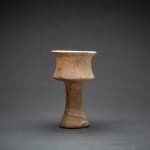Bactria-Margiana Archaeological Complex Alabaster Goblet, 2000 BCE - 1500 BCE
Alabaster
height 14 cm
height 5 1/2 in
height 5 1/2 in
LK.037
Bactria Margiana Archaeological Complex (BMAC) is a modern collective term referring to the combined area of archaeological discoveries that point to the existence of a hitherto unknown uniform bronze age...
Bactria Margiana Archaeological Complex (BMAC) is a modern collective term referring to the combined area of archaeological discoveries that point to the existence of a hitherto unknown uniform bronze age civilization in the area of central Asia. Bactria is the ancient Greek name for the area of Bactra (modern Balkh) in northern Afghanistan and the northeast corner of Iran, while Margiana is again the ancient Greek name for what was the Persian satrapy of Margu and is today south-eastern Turkmenistan and southern Uzbekistan. Through the region runs the Amu Dar'ya River, which was known in Greek history as the Oxus River, hence this newly found culture has also become known as the Oxus Civilisation. News of this lost civilisation began leaking out in the 1970s, when archaeologists came to dig in the southern reaches of the Soviet Union and in Afghanistan. Victor Sarianidi, a Soviet archaeologist of Greek extraction, supervised the excavations which led to the uncovering of this culture and to the discovery of more than 200 settlements, dating to the Bronze and early Iron Age. The Bactria-Margiana culture spread within a large continuous zone across an area encompassing vast regions of the modern countries of Iran, Turkmenistan, Tajikistan, Uzbekistan and Northern Afghanistan. Flourishing between about 2100 and 1700 BC, it was contemporary with the Bronze Age and was characterised by monumental architecture, social complexity and extremely distinctive cultural artefacts that vanished from the record shortly after they first appeared.
The exact identity of the BMAC culture has yet to be fully identified due to the lack of written evidence at the sites excavated up to know, although pictographs on a tiny stone seal have been argued to indicate an independently-developed writing system, thus considering the BMAC to be a literate civilisation.
Commercial trade and indirectly cultural contacts appear to have been of a certain importance, as artefacts of this culture have been discovered all over the Persian Gulf as well as in the Iranian Plateau and the Indus Valley. However the material evidence which has been brought to light is strongly indicative of a powerful country mostly due to the exceptional fertility and wealth of its agricultural lands. This in turn gave rise to a complex and multifaceted set of societies with specialist craftsmen who produced luxury materials for the ruling and aristocratic elites.
Through local stone, carvers inhabiting the regions of Bactria-Margiana did not experience any shortage in material; the main raw material was soft steatite or a dark soapstone, but also various kinds of marble and white-veined alabaster. The main source for these stones, including semi-precious lapis-lazuli, was at Badakhshan in north-western Afghanistan, which provided material not only for the Bactria-Margia carvers but also farther to the west into Mesopotamia, for the Assyrian kings. White-veined alabaster was indeed used for a variery of vessels, including small vases in the shape of goblets with disproportionately long stems and low capacity, such as the ones here illustrated.
These vessels, given the nature of the material and the craftsmanship required, had in all probability a ritual purpose and not a mundane daily function.
The exact identity of the BMAC culture has yet to be fully identified due to the lack of written evidence at the sites excavated up to know, although pictographs on a tiny stone seal have been argued to indicate an independently-developed writing system, thus considering the BMAC to be a literate civilisation.
Commercial trade and indirectly cultural contacts appear to have been of a certain importance, as artefacts of this culture have been discovered all over the Persian Gulf as well as in the Iranian Plateau and the Indus Valley. However the material evidence which has been brought to light is strongly indicative of a powerful country mostly due to the exceptional fertility and wealth of its agricultural lands. This in turn gave rise to a complex and multifaceted set of societies with specialist craftsmen who produced luxury materials for the ruling and aristocratic elites.
Through local stone, carvers inhabiting the regions of Bactria-Margiana did not experience any shortage in material; the main raw material was soft steatite or a dark soapstone, but also various kinds of marble and white-veined alabaster. The main source for these stones, including semi-precious lapis-lazuli, was at Badakhshan in north-western Afghanistan, which provided material not only for the Bactria-Margia carvers but also farther to the west into Mesopotamia, for the Assyrian kings. White-veined alabaster was indeed used for a variery of vessels, including small vases in the shape of goblets with disproportionately long stems and low capacity, such as the ones here illustrated.
These vessels, given the nature of the material and the craftsmanship required, had in all probability a ritual purpose and not a mundane daily function.



